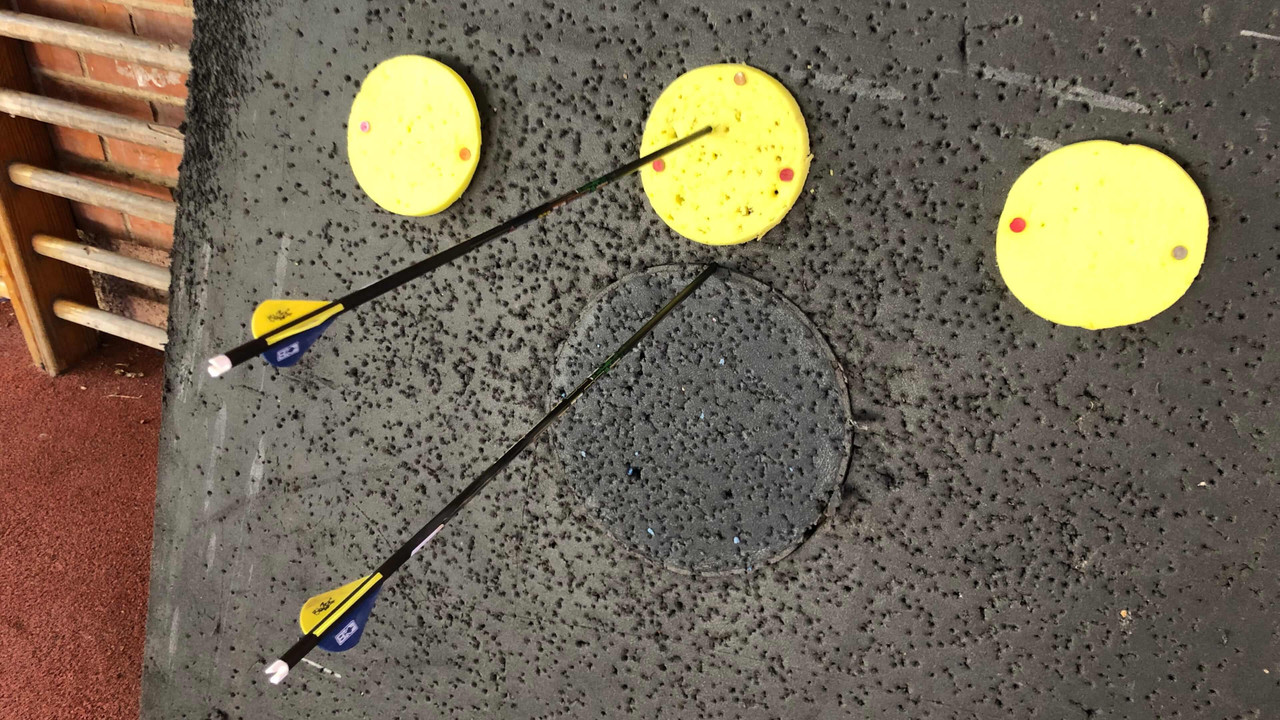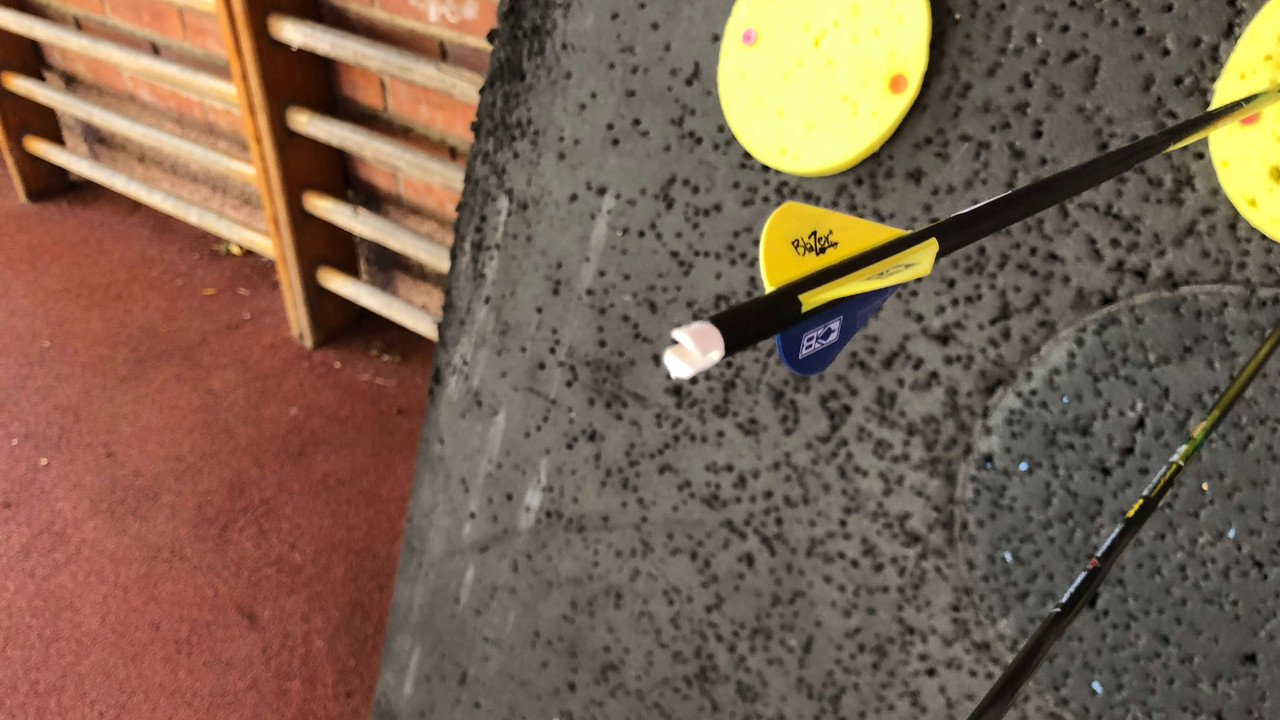Uniting 3D printing and archery: parametric nocks, a cheap and reliable alternative
For an emergency or to save a few bucks... you'll be amazed!
The nock is the part of the arrow that holds the bowstring and is inserted into or placed over the shaft. It is typically made in various colors (usually solid or translucent), materials (the most common being polycarbonate), and sizes (G, F, X, A, H, S, and GT). Regardless of its characteristics, all nocks have one thing in common: they degrade with use until they break.
Why do they break?
A nock has three distinct parts:
- The insert
- The notch
- The guide
The insert is the part of the nock that, as its name suggests, is inserted into the shaft (or over it). To ensure it attaches securely to the shaft (whether aluminum, carbon fiber, fiberglass, or wood), resin is typically applied to bond it.
The notch is the part of the nock that holds the bowstring and allows the arrow to be drawn back before being launched at the chosen target. It consists of two components: 1) the mouth, which is the channel through which the bowstring passes, and 2) the throat, which is the cavity where the bowstring rests after passing through the mouth.
The guide is a very small part of the nock used to align it with the index vane1, depending on the bow you're using (arrows are generally aligned differently for compound bows compared to recurve bows).
When your arrows hit the target (whatever it may be), some of the kinetic energy travels back through the arrow, from the tip to the nock. Of the three parts of the nock, the ones that suffer with every impact are the insert and the notch. The insert is vulnerable because it connects the nock to the arrow and is one of the arrow's weak points (the tip insert being the other weak point). The notch endures constant friction (when attaching the string) and impact (whether the arrow hits the target or not) throughout your archery session.
The two most common types of breakage (at least in my experience) are insert breakage and notch breakage. Insert breakage occurs when the insert splits in two from the impact, leaving part of the insert stuck inside the arrow shaft. Notch breakage occurs when one of the two sides of the notch (left or right—it doesn't matter) breaks or cracks, leaving the nock's head fragmented. This is usually due to the material contracting and expanding when the bowstring is attached or released during the arrow's launch. The arrow's impact also contributes to this process (if one side of the notch is already damaged, each impact worsens the damage until it breaks).
What should I do if they break?
Sometimes, after an impact, the nock comes loose from the shaft. If it's undamaged, you can simply reapply some resin to glue it back. Otherwise, your only option is to replace it.
How much does a new nock cost?
In most archery shops or stores that sell archery-related items, nocks are usually sold in packs of 10 (though this may vary depending on the product) at a price that, depending on the brand, ranges from €2.50 to €40. It's hard to pinpoint an average price since it fluctuates over time, but let's say the average cost of a pack of 10 polycarbonate nocks from brands like Bearpaw, Bohning, or Easton is around €4-6. This gives us an average cost per nock of about 50 cents.
Considering that archery-related products are neither excessively cheap nor outrageously expensive (though this depends on the brand and product as it's not the same buying nocks as it is buying a bow), we could say that 50 cents per nock isn't a bad price. But... can it be improved? Without a doubt, yes. :)
Parametric nocks: A cheap and reliable alternative
Okay, but before diving in...
What is 'parametric'?
Parametric design, as defined by Wikipedia, is a design technique in which the elements we create are generated based on algorithms (or functions) and a series of parameters to define any geometric shape to our liking. The design of the nock was made possible by applying these principles using the OpenSCAD application.
Parametric nocks?
I've always wanted to design a type of nock that adapts to any outer and inner shaft diameter, where you can choose whether to include the guide (not everyone uses or needs it, though it's usually standard) or not, as well as adjust the length of the insert or notch. Plus, you can take the design and 3D print nocks at a controlled cost (depending primarily on the filament you have available and the quality of the print). In short... a custom-tailored nock.
How can I get them?
You can find the parametric nock design, along with other interesting designs, on my Cults profile. Once downloaded, just open the .scad file, adjust the measurements to your liking (unless the default settings work for you), press the F6 key to render the nock, and once finished, press F7 to export the result to a .stl file. You can then open it with your preferred 3D printing application or the one bundled with your 3D printer (I personally use FlashPrint).
Will they work with my 3D printer?
The resulting .stl file should work on any 3D printer model, regardless of its printing technology (FDM2 or SLA3). On my 3D printer (Flashforge Adventurer 3, an FDM type), they work perfectly with PLA (which I use most often) or PETG (I never print with ABS).
What type of arrows can I use the nocks with?
This parametric nock model is designed to be inserted inside the arrow shaft, which can be made of aluminum, carbon fiber, or fiberglass. In a future update, you will be able to use them with pin inserts or wooden shafts.
Are they cost-effective?
My 3D printer (Flashforge Adventurer 3) supports 180mm filament spools, and when I have to buy filament, I usually do so in 300-gram spools. These are more expensive than buying a 1-kilogram spool of filament. A filament spool that I often buy (on Amazon) is this one: WINKLE Filamento PLA HD Ash Gray. At the time of writing this, it costs 12.90 euros (although that could change). Printing a single arrow nock consumes around 1.13 grams of filament.
Let's organize this data clearly:
- A filament spool costs me 12.90 euros and contains 300 grams
- An arrow nock consumes 1.13 grams of filament
Therefore:
- One filament spool will allow me to print 265 arrow nocks (300 / 1.13 = ~265.48)
And now, let’s compare this with the arrow nocks you can buy:
- A bag of 10 arrow nocks has an average cost of around 5 euros (just as an estimate)
- A single arrow nock has an average cost of about 50 cents
- Buying 265 arrow nocks would cost me approximately 132.50 euros4
Conclusion:
- The cost of printing them would be reduced to approximately 9.75%4 (12.90 / 132.50 = ~9.73)
Obviously, it's not as great as it sounds: first, you need to have a 3D printer, filament, and take into account the printing time and, therefore, the cost of the electricity consumed. I could make a much more precise calculation, but one thing is clear: the cost would still be lower than if you bought them. Maybe the final percentage wouldn't be under 10%. Let’s say, in the worst-case scenario, it's 20%. The numbers still add up for me :P
Are they reliable?
I believe in leading by example. Here's a Vimeo video showing the functionality of my parametric nocks:
Although in the video you can see only one arrow, I fired two and this is the result:

I think the archer needs some fine-tuning, but you can see that both arrows have hit the breast wall without any problem. There is no damage to the nock or the arrow shaft (which is to be expected). The arrows are Skylon brand (EDGE model, 6.2 mm inner diameter, 500 Spine, Blazer feathers and 125 grain tips).

As you can see, they work perfectly. Flexible, functional, and customizable. What more could you ask for? :)
Should I stop buying nocks and start printing them?
I'm not trying to boycott archery stores. On the contrary: there are stores I'm in love with like Arco y Luna, CERRA, Hattila or MoitoArchery we're I'll still buy my risers, limbs and other accesories whenever I need to. Parametric nocks are a great option and they work extraordinarily well for me and if they work for me I'm sure they'll do wonders to you. If you decide to try them, I hope you enjoy them. :)
WARNING: It's very important to trim the printed parts to remove any burrs or defects. Leaving the throat of the nock untrimmed may damage the bowstring and cause it to break.
1. Also called index vane because it’s used as a reference to achieve a consistent shot and trajectory for each arrow.
2. FDM (Fused Deposition Modeling) is the technology used by filament-based printers.
3. SLA (Stereo Lithography Apparatus, or simply Stereolithography) is the technology used by resin-based printers.
4. Using very rough math, as they say. For example, I’m not accounting for electricity costs.